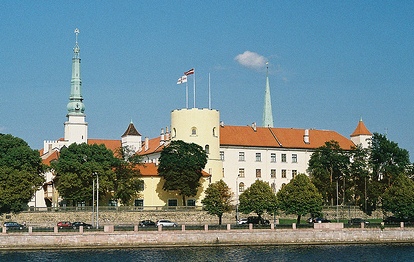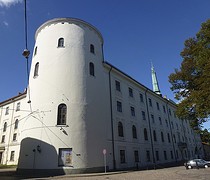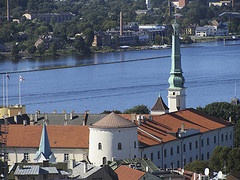

Pils laukums 3


Riga Castle (Rīga Ordeņpils) is a medieval palace, the residence of the President of the Republic of Latvia in Riga, on the banks of the Daugava. Castle of the Livonian Order - the master's residence was built in this place at the end of the 1340s (Riga II Order Castle), destroyed in 1484, and rebuilt in 1515 (Riga III Order Castle). Later, the palace housed the residences of Polish and Swedish regional governments, then the seat of the governors-general of the Baltic provinces (Riga) and Vidzeme of the Russian Empire. When Latvia became an independent country, the residence of the President of the Republic of Latvia was established in the palace. During the Soviet era, the Palace of Pioneers and various museums were located in the palace, but after the restoration of Latvia's independence, it was restored. Representation rooms and the State President's apartments are arranged in the palace. An architectural monument of national importance, one of the dominants of Old Riga, one of the most outstanding medieval castles in Latvia. The interior of the Ambassadors' Accreditation Hall of the Riga Castle is included in the architecture and design section of the Latvian cultural canon.
The first Castle of the Order of the Sword Brothers (Rīga I
Ordenpils) was located on the site of the present-day Convent homestead
in Old Riga. The citizens of Riga destroyed the castle during the
Livonian Civil War with the Livonian Order (1297-1330). In 1330, due to
the terms of the peace treaty of the Livonian Civil War, the city of
Riga had to restore the fortress of the Livonian Order in Daugavmala
instead of the former Hospital of the Holy Spirit. From this place, the
order could control ship traffic in the Daugava. The place is indicated,
but judging by historical sources, the Livonian Order itself has to
organize most of the construction of the palace. The construction of the
castle (Riga II Order Castle) was completed at the end of the 1340s -
this castle is called Monheim Eberhard Castle in historians' circles
after the name of the founder of the new castle, the then master of the
Livonian Order. After the completion of the palace, the residence of the
Livonian Master was moved from Vīlanda Palace to Riga Palace in the
1340s. Due to the destruction of the Riga Castle, in 1481 the master of
the Livonian Order, Bernds von der Borch, moved with the order's archive
and treasury to the medieval castle of Cēsis. From that time, the
residence of the Livonian Order was located in Cēsis. In 1484, as a
result of the internal wars of the Livonian Confederation, the Riga II
Order Castle was once again completely destroyed.
In 1491 - 1515,
the castle was rebuilt on the foundations of the old castle. Above the
main entrance to the palace were placed the sculptures of Saint Mary and
the Land Master of the Livonian Order of that time, Walter von
Plettenberg, which have survived to this day. In 1562, Gotthards Ketler,
the last master of the Livonian Order, handed over the regalia of the
order to the representative of the Polish king, Nikolay Radvil, in the
premises of Riga Castle, and thus the Livonian Order ceased to exist. On
March 12, 1581, King Stefans Batory arrived at the Riga Castle and took
the oath of loyalty to the Free City of Riga. The 1582 Jama Zapolska
peace treaty mentions the big and small Riga citadel (Latin: arx Riga
maior,& arx Riga minor).
In 1621, the castle came under the
control of the Swedish king and the governors-general of the Swedish
Vidzeme resided in it, the work of arranging and strengthening the
abandoned castle was started. In 1783, the facade seen today was built
for the palace, and other reconstruction works are also underway. In
1795, the residence of the Governor General of Riga (Vidzeme) was
arranged in the palace, which remained here until 1917. During the
Russian Empire, the palace arsenal was transformed into the present
Eastern Annex. In the 1860s, public science organizations also entered
the palace - the premises of the Society of Baltic Antiquity and
Historical Researchers and the Literary and Practical Society of Riga
Citizens were located here. This is how the foundation was laid for the
use of Riga Castle for museum purposes.
During the Latvian
freedom struggle in the summer of 1919, the Latvian flag began to fly in
the castle tower. The offices of the President of Latvia and the office
and representation of the Prime Minister of Latvia were arranged in the
Riga Palace. The President was given rooms in the northern part of the
palace, the former rooms of the Governor General. The presidents of the
first free state worked and lived in the palace. In 1921, Eženas Laubi
and Ansi Cīruli were invited to furnish the interior of the premises.
From 1938 to 1939, Eugene Laube redesigned the office of Kārlis
Ulmanis, modernized the palace vestibule, built the highest palace tower
- the Three Star Tower, built a festive hall and arranged the State
President's office in the Antechamber. These conversions produced
outstanding Art Deco interiors and works of art.
Immediately
after the destruction of Latvian independence in 1940, the Council of
People's Commissars of the Latvian SSR settled in the former
presidential palace. In January 1941, the Council of People's Commissars
of the Latvian SSR made a decision to hand over Riga Castle to the needs
of the Republic's pioneers, and in February 1941, the Pioneer Palace was
established in the northern part of the castle. In 1952, the Pioneer
Palace of the Latvian SSR was handed over to the Executive Committee of
the Riga City Council of Workers' Deputies and renamed the Riga Pioneer
Palace. In 1956, the painting by Gederts Elias "1905" was added to the
paintings of the Feast Hall. year", T. Graš "Dziesmu svetki" and P.
Ozoliņa "Ligo svetki".
On November 11, 1988, the national flag of
Latvia was raised again in the castle tower. In 1994, the President of
Latvia returned to the palace.
On the evening of June 20, 2013, a
high-risk fire broke out in Riga Castle, in which the roof structures
and attic of the palace with an area of 2400 square meters, as well as
the fourth floor of the palace with an area of 600 square meters and
the third floor with an area of 200 square meters were damaged. The
Red Hall of the State President's Palace was almost completely burnt
down, the White Hall, the Celebration Hall, the Hall of Envoys and the
Hall of Coats of Arms were less damaged. Part of the premises of the
National History Museum was also damaged in the fire. The fire was
extinguished the next day at 14.21.
On November 11, 1988, the
national flag of Latvia was raised again in the castle tower. In 1994,
the President of Latvia returned to the palace.
On the evening of
June 20, 2013, a high-risk fire broke out in the Riga Castle, in which
the roof structures and attic of the castle with an area of 2400 square
meters, as well as the fourth floor of the castle with an area of 600
square meters and the third floor with an area of 200 square meters were
damaged. The Red Hall of the State President's Palace was almost
completely burnt down, the White Hall, the Celebration Hall, the Hall of
Envoys and the Hall of Coats of Arms were less damaged. Part of the
premises of the National History Museum was also damaged in the fire.
The fire was extinguished the next day at 14.21.
At the end of
2015, the restoration of the Forecourt and the Eastern Annex of Riga
Castle, which lasted for 3 years, was completed. On August 22, 2016, the
President of Latvia Raimonds Vējonis returned to his renovated
workplace.
According to the plans of the 17th century, the castle was originally
surrounded by water barriers on all sides.
There are no surviving
images of the Riga II Castle of the Order drawn by contemporaries,
information about its construction is quite contradictory. It is
difficult to distinguish the building elements of the Order II and III
castles.
The medieval part of the castle of the IIIrd Order
visible today is close to a square in plan, the length of the sides of
which is around 53-57 meters. The medieval castle had four enclosures
that included a courtyard. Massive round towers are built in the
south-east and north-west corners, smaller quadrangular towers are in
the other two corners. Today, the castle has six towers - in the corners
of the castle is St. Spirit, Lead, Piper, North Tower. Two towers have
been built since the Middle Ages, the Oriel Tower (mid-17th
century[citation needed]) and the Three Star Tower (1938-1939). The
walls of the castle are about 3 meters thick.
Remains of
underground passages have been found several times in the vicinity of
the castle.
In the inner courtyard of the palace there are two
outstanding Late Gothic - Mannerist reliefs - "Master Walter von
Plettenberg" (1515) and "Madonna and Child" (1515). The bay window
tower, built in 1649, is richly decorated with reliefs of the early
Baroque style.
Office of the President
To get to the office of
the President of Latvia, you have to go through an enfilade consisting
of three different offices - the Green Room, the Adjutant's Room (Red
Room) and the Secretary's Office (Blue Room). In the green salon there
are paintings by Július Feder and a set of Biedermeier mahogany
furniture. In the adjutant's room, there are portraits of Latvian rulers
and a showcase with state awards. Portraits of Garlīb Merkėlis and Johan
Kristof Broce are placed in the secretary's office.
Eugene Laube
created an office for Kārlis Ulman by combining two rooms of Gustavus
Zemgal's apartment. The oak doors leading to the president's apartment
after the year of the President's work were brought from Apriķi
manor.[3] Previously, paintings by Vilhelm Purvīš were placed in the
cabinet, but since 2015 they have been replaced by paintings by Dace
Liela and Līga Purmale.
White grass
The White Hall used to be
called the Emperor's Hall. The hall was built in 1818 and its architect
was Friedrich Christian von Breitkreitz. In honor of the visit of the
Emperor of the Russian Empire, Alexander II, according to Paul
Hardenak's project, from 1860 to 1862, the hall was transformed into
classicist forms. In 1938, during the rebuilding of the hall, it
acquired a light tone and the name White Hall. After the fire in 2013,
which destroyed the ceiling of the White Hall, it was rebuilt based on
the instructions found in the archive materials.
Envoy
Accreditation Hall
This hall is considered the most authentic example
in the palace from the time of Latvia's first independent state and an
original contribution of the Latvian Art Deco interior style to the
world. Therefore, this hall is included in the cultural canon of Latvia.
The hall has been created in the former drawing room of the Great
Palace. According to Jānis Čakste's order, the interior of this hall was
designed by Ansis Cīrulis.
Hall of coats of arms
This was
originally the Red Hall, or the Governor General's Dining Hall, which
was converted into the Coat of Arms Hall in 1929 when the Swedish King
Gustav V was welcomed. In the process of creating the hall, the coats of
arms of Latvian cities were depicted on the ceiling. During the
reconstruction of the hall in 2015, the ceiling pattern was supplemented
with the missing coats of arms. Portraits of the four first presidents
of Latvia are placed on the walls. In the hall there are Karelian birch
furniture sets purchased in the late 1920s, from which it is possible to
create a meeting room for up to 80 people.
Festive hall
The
banquet hall was opened in 1938 for the celebration of the 20th
anniversary of Latvia. The author of the hall project is Eižens Laube
and it is designed in the wooden architecture of old palaces with a
Latvian feel. The hall was created within 6 months and the errors of its
rapid construction were detected and corrected during the reconstruction
of the hall, as well as the great damage caused to the hall by the fire
of 2013. The area of the hall is 470 m3 and it stretches to the middle
of the Eastern Annex. During the reconstruction, the windows that were
bricked up in 1938 were restored. At the southern end of the hall, the
Musicians' balcony was restored, where a stage was built in Soviet
times.